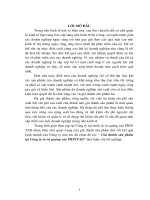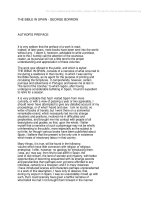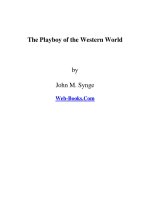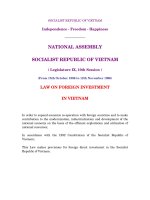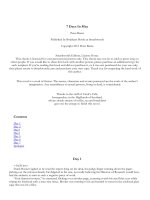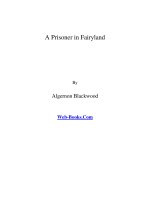Western esotericism in scandinavia
Bạn đang xem bản rút gọn của tài liệu. Xem và tải ngay bản đầy đủ của tài liệu tại đây (3.1 MB, 717 trang )
Free ebooks ==> www.Ebook777.com
www.Ebook777.com
Free ebooks ==> www.Ebook777.com
i
Western Esotericism in Scandinavia
© koninklijke brill nv, leiden, 2016 | doi 10.1163/9789004325968_001
www.Ebook777.com
ii
Brill Esotericism Reference
Library
Series editor
Wouter J. Hanegraaff
The titles published in this series are listed at brill.com/berl
Western Esotericism
in Scandinavia
Edited by
Henrik Bogdan
Olav Hammer
LEIDEN | BOSTON
iii
Free ebooks ==> www.Ebook777.com
iv
Cover illustration: Magical sigil from the collection of King Charles XIII, used by permission of the Library
and Archives of the Swedish Order of Freemasons.
Library of Congress Cataloging-in-Publication Data
Names: Bogdan, Henrik, editor.
Title: Western esotericism in Scandinavia / edited by Henrik Bogdan, Olav
Hammer.
Description: Boston : Brill, 2016. | Includes bibliographical references and
index.
Identifiers: LCCN 2016002650 | ISBN 9789004302419 (hardback : alk. paper)
Subjects: LCSH: Occultism--Scandinavia--Encyclopedias.
Classification: LCC BF1434.S25 W47 2016 | DDC 135/.40948--dc23
LC record available at />
Want or need Open Access? Brill Open offers you the choice to make your research freely accessible
online in exchange for a publication charge. Review your various options on brill.com/brill-open.
Typeface for the Latin, Greek, and Cyrillic scripts: “Brill”. See and download: brill.com/brill-typeface.
issn 2468-3566
isbn 978-90-04-30241-9 (hardback)
isbn 978-90-04-32596-8 (e-book)
Copyright 2016 by Koninklijke Brill nv, Leiden, The Netherlands.
Koninklijke Brill NV incorporates the imprints Brill, Brill Hes & De Graaf, Brill Nijhoff, Brill Rodopi and
Hotei Publishing.
All rights reserved. No part of this publication may be reproduced, translated, stored in a retrieval system,
or transmitted in any form or by any means, electronic, mechanical, photocopying, recording or otherwise,
without prior written permission from the publisher.
Authorization to photocopy items for internal or personal use is granted by Koninklijke Brill nv provided
that the appropriate fees are paid directly to The Copyright Clearance Center, 222 Rosewood Drive,
Suite 910, Danvers, ma 01923, usa. Fees are subject to change.
This book is printed on acid-free paper and produced in a sustainable manner.
www.Ebook777.com
Contents
Contents
Contents
List of Contributors xii
Introduction 1
Henrik Bogdan and Olav Hammer
Alchemy
in Denmark 11
Morten Fink-Jensen
in Finland 18
Tomas Mansikka
in Norway 25
Gina Dahl
in Sweden 33
Carl-Michael Edenborg
Anthroposophy
in Denmark 43
René Dybdal
in Finland 49
Kennet Granholm
in Norway 53
Ingvild Sælid Gilhus
in Sweden 58
Håkan Lejon
Astrology in the Early Modern Period
in Denmark 64
Morten Fink-Jensen
in Norway 70
Gina Dahl
v
vi
Contents
in Sweden 78
Kjell Lekeby
Astrology in the Contemporary Period
in Denmark 89
Kirstine Munk
in Finland 98
Tom Sjöblom
in Sweden 104
Jenny-Ann Brodin Danell
Christian Theosophy
in Denmark 113
Søren Feldtfos Thomsen
in Finland 119
Tomas Mansikka
in Norway 127
Jan-Erik Ebbestad Hansen
in Sweden 137
Fabian Linde
Freemasonry
in Denmark 145
Andreas Önnerfors
in Finland 152
Nils G. Holm
in Norway 162
Andreas Önnerfors
in Sweden 168
Henrik Bogdan
Contents
Hermeticism
in Denmark 182
Morten Fink-Jensen
in Sweden 189
Susanna Åkerman
Human Potential 195
Liselotte Frisk
Jungianism 203
Suzanne Gieser
Kabbalah
in Denmark 212
Sara Møldrup Thejls
in Sweden 218
Thomas Karlsson
Magic in the Early Modern Period
in Denmark 228
Morten Fink-Jensen
in Finland 236
Tomas Mansikka
in Sweden 244
Henrik Bogdan and Kjell Lekeby
Martinus 254
Helle Bertelsen
Mesmerism
in Denmark 264
Søren Bak-Jensen
in Norway 269
Tonje Maria Mehren
vii
viii
in Sweden 285
Olav Hammer
New Age
in Denmark 292
Mikael Rothstein
in Finland 301
Tom Sjöblom
in Norway 307
Ingvild Sælid Gilhus
in Sweden 313
Liselotte Frisk
Occultism
in Denmark 319
Sara Møldrup Thejls
in Finland 324
Kennet Granholm
in Norway 332
Geir Uldal and Geir Winje
in Sweden 343
Kennet Granholm
Paganism
in Denmark 350
Benjamin Weber Pedersen
in Finland 360
Titus Hjelm
in Norway 367
Geir Uldal and Geir Winje
Contents
Free ebooks ==> www.Ebook777.com
ix
Contents
in Sweden 380
Fredrik Gregorius
Pansophy 390
Fabian Linde
Paracelsianism
in Denmark 402
Jole Shackelford
in Finland 410
Tomas Mansikka
in Norway 417
Gina Dahl
in Sweden 425
Susanna Åkerman
Rosicrucianism in the Early Modern Period
in Denmark 431
Jole Shackelford
in Sweden 439
Susanna Åkerman
Rosicrucianism in the Contemporary Period
in Denmark 445
Jacob Christiansen Senholt
in Finland 448
Tom Sjöblom and Jussi Sohlberg
in Norway 453
Kjersti Løken
Satanism
in Denmark 463
Jesper Aagaard Petersen
www.Ebook777.com
x
Contents
in Finland 474
Titus Hjelm
in Norway 481
Asbjørn Dyrendal
in Sweden 489
Henrik Bogdan
Spiritualism
in Denmark 494
Jesper Vaczy Kragh
in Finland 500
Jussi Sohlberg
in Norway 506
Tonje Maria Mehren
in Sweden 521
Robert Carleson and Caroline Levander
Swedenborgianism 534
Jane Williams-Hogan
Theosophy
in Denmark 554
René Dybdal
in Finland 563
Kennet Granholm
in Norway 570
Siv Ellen Kraft
in Sweden 578
Einar Petander
Contents
Theosophically Inspired Movements
in Denmark 587
René Dybdal
in Finland 595
Kennet Granholm
in Norway 603
Ingvild Sælid Gilhus and Janemil Kolstø†
in Sweden 606
Einar Petander
Traditionalism
in Denmark 615
Kristian Bjørkelo
in Norway 618
Kristian Bjørkelo
in Sweden 624
Robert Carleson
UFO movements
in Denmark 630
Mikael Rothstein
in Finland 640
Jaakko Närvä
in Norway 650
Jan Bertil Heilund
in Sweden 660
Jonathan Peste
Index of Names 667
Index of Subjects 689
xi
xii
List of Contributors
List Of Contributors
List of Contributors
Susanna Åkerman
PhD, Secretary at Swedenborg Forum, Stockholm. Research interests include
Swedenborgianism, Queen Christina of Sweden, Rosicrucianism and alchemy.
Søren Bak-Jensen
holds a PhD degree in history, and has published several articles on the history
of medicine in Denmark. He is currently Director of the Workers’ Museum in
Copenhagen.
Helle Bertelsen
senior master at Randers Statsskole, Denmark. Primary areas of research are
NRMs and spirituality in Denmark and India.
Kristian A. Bjørkelo
is a folklorist and a freelance writer working with various topics ranging from
extremism to communication science. He teaches communication at the University of Bergen.
Henrik Bogdan
is Professor in Religious Studies at the University of Gothenburg. His main areas of research are New Religious Movements, Twentieth-Century Occultism,
and Freemasonry.
Robert Carleson
MA in History of Ideas and Literature Studies. He is Archivist at the Library and
Archives of the Swedish Order of Freemasonry.
Gina Dahl
Dr. Art. in history of Religion (2007) and a consultant at the Regional State Archives of Bergen, has published extensively on book distribution in early modern Norway.
Jenny-Ann Danell
is Associate Professor and Senior Lecturer in Sociology, at Umeå University.
Her main research is on production and negotiation of knowledge, with special focus on complementary medicine.
List of Contributors
xiii
René Dybdal
is Head of Center for Research and Development in Health Technology at VIA
University College. PhD about Theosophy in Denmark and has furthermore
conducted research on new religions.
Asbjørn Dyrendal
is Professor at the Department of Philosophy and Religious Studies, Norwegian
University of Science and Technology. His main research areas are contemporary Western religion and conspiracy culture.
Jan-Erik Ebbestad Hansen
is Professor in History of Ideas, Department of Philosophy, Classics, History of
Arts and Ideas, University of Oslo. Fields of research: Christian mysticism, esotericism, Faust literature and Norwegian History of ideas.
Carl-Michael Edenborg
PhD in History of Ideas (2002), is a writer, critic, editor, publisher, and historian
of alchemy.
Morten Fink-Jensen
PhD, Associate Professor of History, the Saxo Institute, University of Copenhagen. His research interests revolve around the cultural history of science and
religion in early modern Scandinavia.
Liselotte Frisk
Professor in Religious Studies at Dalarna University, Sweden, since 2006. PhD
with dissertation on New Religious Movements in 1993 at Åbo Akademi, Finland. Research areas include New Age and children in minority religions.
Suzanne Gieser
PhD in the History of Sciences, Uppsala University, licenced relational psychotherapist. Research areas: History of Dynamic Psychology in Sweden, Jung History.
Ingvild Sælid Gilhus
is Professor of Religion at the University of Bergen, Norway. She works in the
areas of religion in late antiquity and New Age spiritualities.
xiv
List Of Contributors
Kennet Granholm
is Docent in Comparative Religion at Åbo Akademi University. He has published extensively on contemporary esotericism and new religions, popular
culture, and sociological method and theory.
Fredrik Gregorius
PhD, is Senior Lecturer in History of Religions at Linkoping University, Sweden.
His main areas of research are American Evangelical movements, contemporary European Paganism, and African-American diaspora religions.
Olav Hammer
is Professor of the Study of Religions at the University of Southern Denmark.
His main areas of research are new religious currents and Western esotericism
in the post-Enlightenment West.
Jan Bertil Heilund
PhD, primary research on Norwegian UFO groups and organisations, teaches at
Bergen Cathedral School.
Titus Hjelm
is Reader in Sociology at University College London. His main areas of interest
are sociology of religion, social theory, social problems, media, and popular
culture.
Nils G. Holm
professor em. of Åbo Akademi University, Finland. He has been teaching world
religions for more than thirty years, especially psychology of religion. He holds
a Dr. Theol. from Uppsala University, Sweden.
Thomas Karlsson
PhD, Stockholm University, Sweden. His main focus is Renaissance and Baroque esotericism and Scandinavian Kabbalah, as well as contemporary Left
Hand Path occultism. Karlsson is Director of the Esoteric Crossroads seminars
on Villa San Michele, Capri, Italy.
Janemil Kolstø†
was a doctoral candidate who worked on a thesis on the Share International
movement.
List of Contributors
xv
Siv Ellen Kraft
is Professor of Religious Studies at the University of Tromsø, Norway’s Arctic
University. Major Research interests include Theosophy, New Age, Neo-paganism, and Indigenous religion(s).
Jesper Vaczy Kragh
Associate Professor, MA, PhD, is currently working on a research project funded by the Danish Ministry of Culture and the Danish Agency of Culture.
Håkan Lejon
retired priest of the Church of Sweden and Waldorf teacher, completed a PhD
dissertation on anthroposophy in Sweden at Stockholm University in 1997.
Kjell Lekeby
BA is a private scholar in history of ideas, specialising in alchemy, astrology,
magic, and Freemasonry.
Caroline Levander
is a PhD Candidate in Art History at the University of Gothenburg. Her research is focused on esoteric ideas expressed in late Nineteenth- and early
Twentieth-Century art.
Fabian Linde
(PhD) is a Postdoctoral Researcher at the Uppsala Centre for Russian and Eurasian Studies (UCRS), who specialises in Russian intellectual history.
Kjersti Løken
MA in History of Religions, is a private scholar. She is the author of an MA thesis
on AMORC in Norway.
Tomas Mansikka
Phil. Lic. Independent researcher in the fields of History of Ideas, History of
Religions, Philosophy, Reformation Culture, Western Esotericism.
Tonje Maria Mehren
is a historian of ideas specialising in Spiritualism, parapsychology, and psychic
research in Norway.
xvi
List Of Contributors
Kirstine Munk
completed a PhD dissertation in 2008 on the role of astrology in contemporary
society, with a special focus on astrology in Denmark.
Jaakko Närvä
PhD, Religious Studies. Primary areas of research: UFO religiosity and philosophy of Religious Studies.
Andreas Önnerfors
is an Associate Professor in Intellectual History at the University of Gothenburg, Sweden. His main areas of research are the intellectual culture of the
Enlightenment and organised sociability, Freemasonry, and fraternal orders of
the period.
Benjamin Weber Pedersen
is part-time Lecturer in the Study of Religions at the University of Southern
Denmark. His main research interests are Norse religion, occultism, and contemporary pagan movements.
Jonathan Peste
PhD in History of Religions, is an independent scholar. His main areas of research are Hermetism, Gnosticism, and the relation between religion and violence.
Einar Petander
is doctoral candidate in Comparative Religion at Åbo Akademi University. His
main focus of research is the history of Theosophy, particularly in a Swedish
context.
Jesper Aagaard Petersen
is Associate Professor of Religion and Education at the Norwegian University
of Science and Technology, Trondheim, Norway. His primary research interests
include contemporary Satanism and Left-Hand Path groups, religion and science, and art as transgression.
Mikael Rothstein
PhD is Associate Professor/Senior Lecturer of Comparative Religion, University of Southern Denmark, and Visiting Professor, Vytautas Magnus University,
Kaunas. He specialises in the study of hunter-gatherers and new religions in
the West.
List of Contributors
xvii
Jacob Christiansen Senholt
PhD candidate in history of ideas, University of Aarhus, research areas include
political and religious radicalism, traditionalism, political esotericism, occultism, and neopaganism.
Jole Shackelford
Assistant Professor of the History of Medicine, University of Minnesota Medical School. His areas of research include Early European Science and Medicine, and History of Chronobiology.
Tom Sjöblom
ThD, is a Docent in the Study of Religions at the University of Helsinki. His research objects include the origins of religious thinking, magic in the Middle
Ages, and pre-Christian religions in Europe.
Jussi Sohlberg
MTh, is a research coordinator at the Research Institute of the Lutheran
Church in Finland. He is specialised in Western esotericism and Alternative
Spirituality.
Sara Møldrup Thejls
holds an MA in history of religions from University of Copenhagen and University of Amsterdam. Her main research interests are esotericism, Kabbalah,
New Age, and New Religious Movements. She is employed as a religious studies teacher at Helsingoer High School in Denmark.
Søren Feldtfos Thomsen
PhD is Postdoctoral researcher at Aarhus University, Department for the Study
of Religion.
Geir Uldal
has studied and practised ritual magic and related concepts since the 1970s,
and has many contacts in Norwegian paganistic and occult milieus.
Jane Williams-Hogan
Professor Emerita at Bryn Athyn College, PA. PhD, University of Pennsylvania,
1985, focusing on the sociology of religion. Co-director of MA of Religious Studies programme. Research area: Swedenborg studies.
xviii
List Of Contributors
Geir Winje
is an Assistant Professor, working with teacher education at Buskerud and
Vestfold University College (Norway). His research fields are religious art and
modern religiosity, such as neopaganism and occultism.
Free ebooks ==> www.Ebook777.com
Introduction
Introduction
1
Introduction
Henrik Bogdan and Olav Hammer Bogdan and Hammer
The Field
In the last two decades or so, the study of Western esotericism has become one
of the most rapidly expanding academic pursuits. Currents ranging in time
from alchemy and Hermeticism of the early modern period to various New
Age pursuits and UFO-related beliefs of the contemporary age are often placed
under this general category. Which substantive characteristics might unite
such a disparate set remains an open and controversial issue. Luckily, this is of
little concern for an encyclopedic work such as ours: considerably less controversy surrounds the question of what contents should be counted as part of the
category of Western esotericism. This partial consensus is in no small measure
due to an authoritative encyclopedia, Hanegraaff et al (2005), which in more
than 1200 pages summarises information on roughly 300 currents, concepts,
and individuals.
With few exceptions, the Dictionary of Gnosis and Western Esotericism
focuses on Western esotericism in countries where the main language of communication is English, German, Italian or French. Even when it comes to the
earlier periods, when most learned works were written in Latin, the same geographical limitation can be observed. In this sense, the Dictionary awaits
follow-up volumes that cover esotericism in other parts of the world where
esoteric currents have been influential: for older periods, the Islamic and
Jewish cultural spheres; for the early modern and contemporary periods,
Eastern and Northern Europe. The present work represents such an attempt,
covering Western esotericism in four Northern European countries: Denmark,
Finland, Norway, and Sweden.
What has been done in the Dictionary need not be redone. We have not
attempted to define or introduce the main currents covered here, nor have we
asked our contributors to do so. We assume that the gamut of currents, ranging
in alphabetical order from Anthroposophy and astrology to Traditionalism and
UFO s, are already at least minimally familiar to our readers. If not, the
Dictionary of Gnosis and Western Esotericism provides extensive coverage of
these and many other relevant terms.
© koninklijke brill nv, leiden, 2016 | doi 10.1163/9789004325968_002
www.Ebook777.com
2
Bogdan And Hammer
The Selection and Organisation of Entries
Sociologist Roland Robertson (1992) coined the term glocalisation to denote
the way in which global ideas, practices, and material objects are adapted to
local conditions. The story of religion in Scandinavia after Christianisation (as
summarised in, e.g., Hammer 2015) is very much the tale of many glocalisations,
and so are the many manifestations of Western esotericism from the early sixteenth century to the present day. Even the most innovative esotericists tended
to mine concepts and practices already found on the European continent, and
produce local, Scandinavian versions. In some cases the degree of adaptation
is minimal: organisations with their headquarters outside of Scandinavia can
open branches in Copenhagen or Stockholm, and run these local branches as
faithful replicas of their counterparts abroad. In other cases the effect of localisation is much more pronounced. When Swedish sixteenth-century esotericist
Johannes Bureus (1568–1652) became familiar with kabbalistic ideas concerning the role of the Hebrew alphabet, he chose to devise a structurally similar
system that assigned occult qualities to the Nordic rune alphabet.
Given the dependence of Scandinavian esotericism on currents developed
elsewhere, it seemed a natural choice to organise our volume in terms of such
currents as they are manifested in each of the Scandinavian countries.
Individual entries will thus provide information on such topics as alchemy in
Denmark, Freemasonry in Norway, Theosophy in Finland, and UFO movements in Sweden, to mention just a few examples. Although the borders
between currents are scholarly constructions, and our choice has at times been
guided by pragmatism rather than hard-and-fast rules, this way of organising
the material should also make it easy for readers unfamiliar with Scandinavian
history to orient themselves in the material. Those who wish to find specific
data on individual people will be able to locate that information by consulting
the detailed index. The single exception to this role is our choice to place
Martinus (1890–1981) and the movement named after him in a chapter of his
own, since his particular form of esotericism is difficult to place into one of the
existing categories.
Over the several years that this book project developed, we have drawn on
the expertise of numerous individuals, from established scholars to rising stars.
Most people we have approached were eager to share their knowledge and
were generous in providing information about colleagues who had explored
the lesser-known nooks and crannies of Western esotericism in a Scandinavian
setting (a brief summary of the existing research that we have drawn on can be
found in Bogdan & Hammer 2008). The reader will nevertheless discover lacunae in the text. To the best of our knowledge, there is at the time of writing
Introduction
3
simply no research on such topics as astrology in contemporary Norway, or the
influence of Traditionalism in Finland. This volume thus serves as a map of the
state of the art on our selected topic, and indirectly provides clues as to potential research topics.
An aid to further research is provided by the bibliographies at the end of
each chapter. Although academic scholarship in the humanities is said to be
internationally oriented, one aspect of these reference lists seems to strikingly disconfirm this notion. Almost all research on esotericism in Scandinavia
has resulted in publications in local languages. If Western esotericism in
Scandinavia is such an uncharted field for most non-Scandinavians, that is the
reason. Much of what appears between the present covers will have been previously inaccessible to those who lack command of a Scandinavian language
and of Finnish. Quotes from Scandinavian- and Finnish-language sources
and scholarship included in the present volume have been translated by the
authors of the respective chapters, unless noted otherwise.
The Scandinavian Countries
Our choice of what countries to include is in part dictated by the extent of our
personal networks and the limits of our own knowledge. Strictly speaking,
Scandinavia is a term that covers three countries with a shared linguistic and
cultural heritage: Denmark, Norway, and Sweden. In an extended sense, the
term Scandinavia is used as a synonym for the (stylistically clumsier) term “the
Nordic countries”, which also includes Finland, Iceland, and the Faeroe Islands.
Until very recently, even distant Greenland was a dependency of Norway (until
1814) and then of Denmark (until colonial status was abolished in 1953).
Politically, but not geographically, Greenland thus also belongs to the immediate sphere of influence of the Nordic countries.
Culturally, not least when it comes to the history of ideas and history of
religion, Finland has been close to the three Scandinavian countries senso
strictu. Swedish was up to the modern period extensively used as a language of
learned communication, and for many years, political fortunes (to be outlined
below) united Finland with Sweden. It therefore seemed natural to include the
situation in Finland in our volume. Iceland, the Faeroe Islands, and Greenland
were excluded for pragmatic reasons only. To the extent that there have been
writers on esoteric topics, organisations with esoteric foci, and researchers
surveying esotericism in these territories, linguistic barriers and our own lack
4
Bogdan And Hammer
of familiarity with the relevant histories have made us decide against covering them. The occasional mention by one or another of our authors – for
instance the fact that the Norwegian priest Hans Egede (1686–1758), missionary to Greenland after 1721, sent for alchemical works and tried to manufacture
the Philosopher’s Stone in his new homeland – suggests that much could be
uncovered outside Scandinavia as we have chosen to define the term. We do, of
course, hope that somebody will take up the challenge and extend the present
survey beyond our self-imposed borders.
For ease of reference, we have allowed a historical anachronism to pervade
our book. We describe the situation in four countries that have seen shifting
borders and where political sovereignty has come and gone over the centuries.
A historically precise identification would have entailed placing some of the
people and events that are covered here in such chapters as “Alchemy in
Norway”, in a separate section that could have a title such as “Alchemy in the
Norwegian Part of the Danish-Norwegian Kingdom”. Such historical precision
comes at the price of both linguistic awkwardness and potential confusion,
especially for readers unfamiliar with the broad political events in Scandinavian
history. A few basic facts that might be included in a thumbnail sketch of the
various fortunes of nations and national borders from the early sixteenth century to today will illustrate why:
The Scandinavian countries were from 1397 to 1523 joined in a political
union, the Kalmar Union, with a single monarch at its head. When our story
begins, various nations were beginning to break away from this union and,
with various degrees of success, assert their national independence and their
dominance over neighbouring territories. In 1523 Sweden definitively broke
out of the union, with Gustav Vasa becoming king. Sweden was at this time a
considerably smaller country than today, since much of the present-day territory was controlled by the Danish crown.
Denmark also broke out of the union at this time, but retained control over
Norway. A double kingdom of Denmark-Norway lasted until 1814, and strictly
speaking, all events described here as taking place in Norway before that year
took place in the double monarchy of Denmark-Norway. This double kingdom
also continued to rule over several of the southern and western provinces of
what later became part of Sweden. Brutal wars between Sweden and Denmark
led to the incorporation of these provinces into Swedish territory in a peace
treaty signed in 1658. By then, Swedish military fortunes had also made the territory of Sweden expand greatly. Parts of the Baltic countries, for instance, had
come to belong to Sweden, but were later lost again: Estonia and Livonia (part
of present-day Latvia) in 1721, and Courland (Western present-day Latvia) in
1795.
Introduction
5
The bond between Sweden and Finland was even stronger. The DanishNorwegian double monarchy concentrated power to Copenhagen, but Norway
had its own legal code and its own institutions. Finland, by contrast, was considered a completely integrated part of the Swedish state from the Middle Ages
up to 1809. After Sweden lost a war against Russia, the Finnish-speaking area
came under two distinct spheres of influence. A territory roughly equivalent to
what is today Finland became an autonomous part of the Russian empire, the
so-called Grand Duchy of Finland, until independence was achieved in 1917. A
much smaller Finnish-speaking area, west of the Torne River, remains an integral part of Sweden to the present day.
These few pointers to the extreme flux that has characterised boundaries
delimiting the Scandinavian countries barely begin to scratch the surface of
the complexities. In short, the decision to divide the topics of the present volume after the present-day geographic entities may perhaps offend purist
historians, but we insist that this is the most sensible option.
Esotericism in Scandinavia: A Brief Overview
The large amounts of information that follow in the body of this encyclopedia
are arranged alphabetically and by country, rather than in a chronological narrative, and are often quite detailed. For newcomers to the history of religions in
Scandinavia, and to the place of Western esotericism within that general history, a thumbnail sketch (with examples culled from various chapters in this
book) may be useful.
Once the Scandinavian countries emerged from the Kalmar Union as
separate entities, Lutheranism was imposed as the only tolerated religion. In
Sweden, religious hegemony had been enforced by the end of the sixteenth
century, and all Swedish citizens were compelled to belong to the Lutheran
state church. In Denmark-Norway, a similar process led to the country-wide
establishment of Lutheran orthodoxy already in 1536. Although religious
dissent was seen as a serious matter, esoteric currents from the European continent – in particular, astrology, alchemy, and kabbalistic and paracelsian ideas
– managed to influence some segments of the population. Three factors in
particular impacted on the dissemination of these early forms of esotericism.
Firstly, they presupposed a considerable degree of specialised and often
bookish knowledge. Given the minuscule size of the Scandinavian intellectual
elite, and its concentration to parts of Denmark and Sweden, relatively few
people were actively involved in promoting such pursuits. The influence of
esoteric currents in the Norwegian part of the double kingdom and in the
6
Bogdan And Hammer
Finnish part of Sweden, which at the time were cultural peripheries, was particularly restricted. In Sweden, for instance, a survey of the available sources
reveals the names of only some eighty active alchemists in the sixteenth and
seventeenth centuries. The situation of astrology was even more extreme: only
one professional astrologer of early modern Sweden is known to us: Sigfrid
Aron Forsius (ca. 1560–1624). It is symptomatic that Johannes Bureus (1568–
1652), who was the most innovative Swedish esotericist of the early modern
period, barely had any influence on his contemporaries.
Secondly, shifting opinions on whether esoteric ideas conflicted with basic
Christian tenets, or with the Aristotelian philosophy that was part of the standard university curriculum, led to an unstable situation where support for
particular practices could be forthcoming for a while, until the tides shifted,
and the same practices were criticised or even banned. Astrology, in particular,
was at times accepted, and at other times perceived as a threat to the fundamental Christian doctrine of free will. In Denmark, astrology was included in
the charter of the University of Copenhagen, formulated in 1539. Tycho Brahe
(1546–1601), the most celebrated astronomer of early modern Scandinavia,
published predictions that drew attention in royal circles. King Frederik II
(1534–1588) felt that Tycho’s methods could be useful in that they delivered
both broad political predictions and information on the fate of individual
members of the royal family. Many theologians, however, were averse to the
practise, and once a less supportive king was in place, the situation of astrology
changed dramatically. In 1633 King Christian IV issued a decree making specific predictions in almanacs forbidden, because the practise might provoke
the ire of the deity.
Thirdly, as a consequence of the first two factors, the situation of at least
some esoteric currents in early modern Scandinavia often depended on the
efforts of a handful of key individuals: sympathetic members of the royal family who chose to support unorthodox ideas, or centrally placed intellectuals
who went against prevailing mainstream opinions. For instance, paracelsianism gained a firm foothold in Denmark largely through the efforts of one man,
Peder Sørensen (1542–1602), better known by his Latinised name Petrus
Severinus, and through the protection of his royal patron. Severinus took the
fundamental ideas of Paracelsus’ medicine, and created a systematic body of
thought. The publication in 1571 of his main work, Idea medicinae philosophicæ, secured him the position as royal physician to King Frederik II of Denmark.
At the cusp of the eighteenth century, Lutheran religious hegemony met
new challenges, and countermeasures became even harsher. In the decades
around 1700, Pietist movements entered Scandinavia from Germany. A form of
religion that saw organised churches as irrelevant to true piety, or even as
